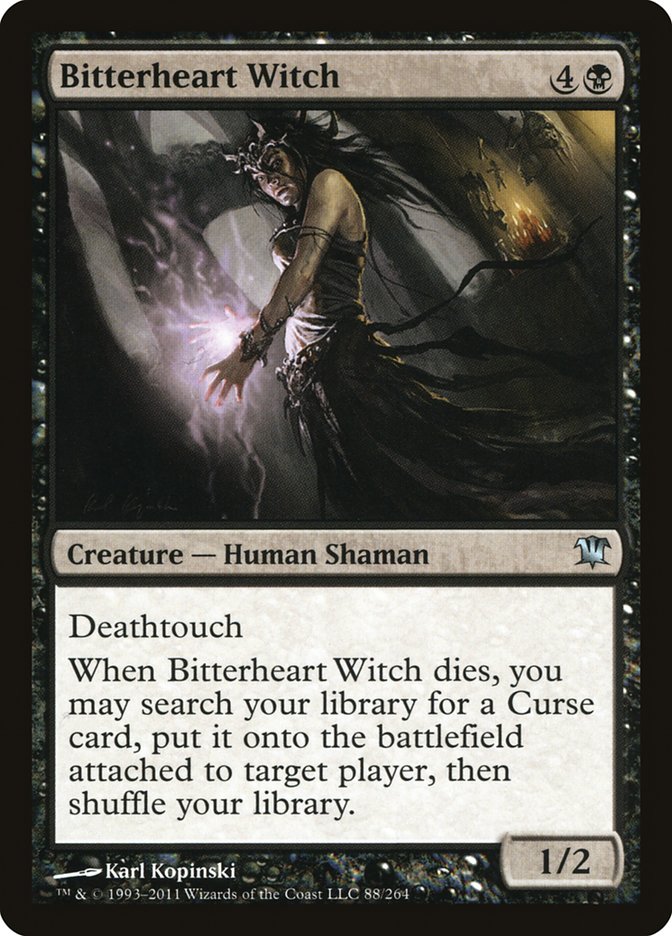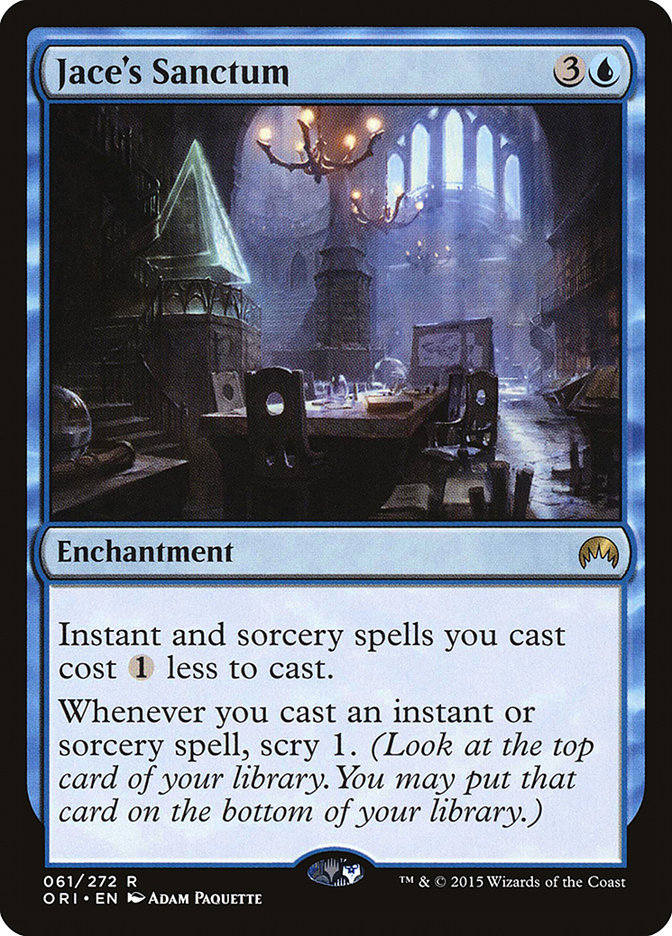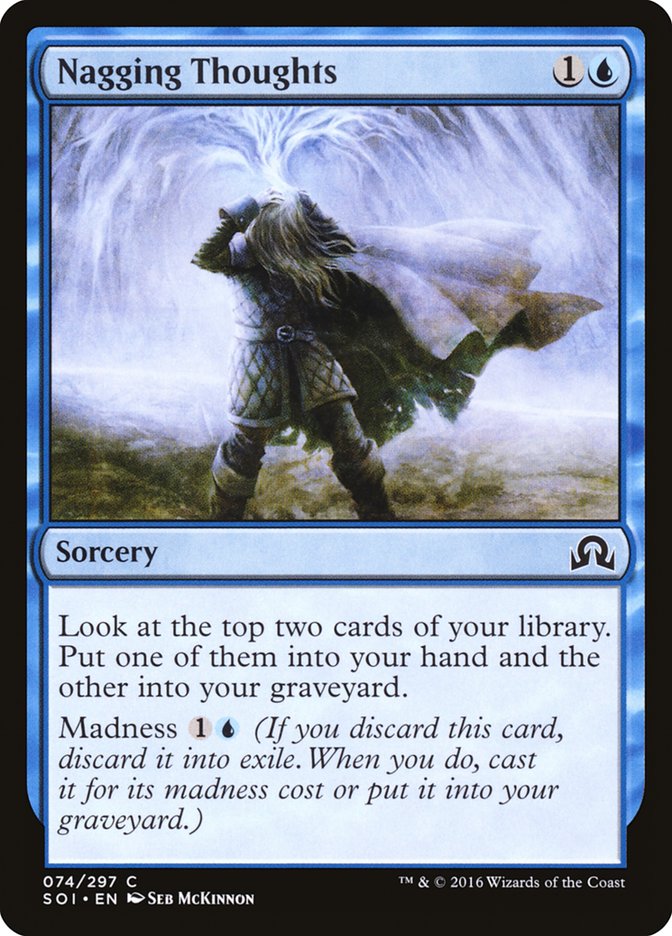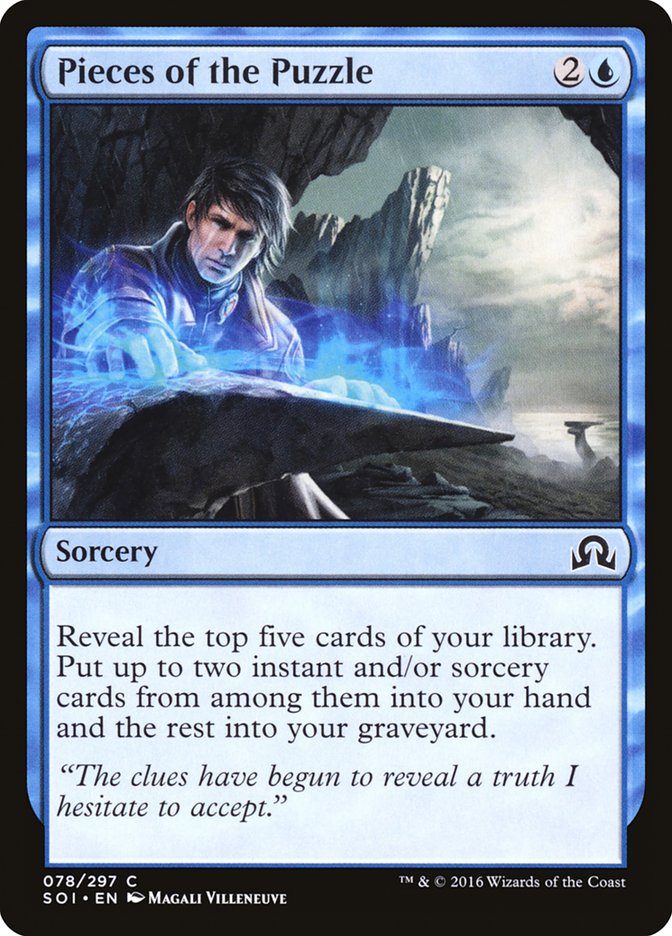In fiction, witches have had an unfortunate history wrought with tales of putrescent evil, incurable plagues and sinister mischief. Truth is, they deserve it.
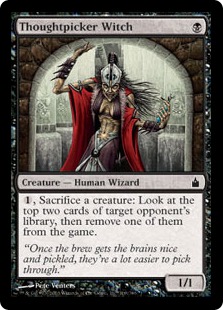
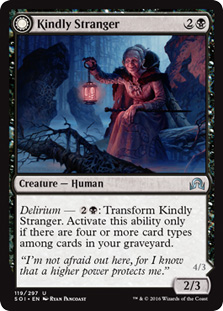
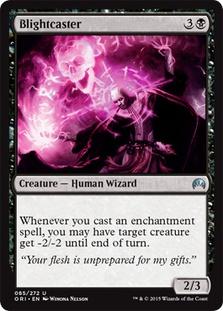
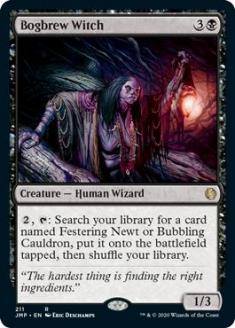
These creatures of sorcery, guile, and seclusion have been a staple of horror fiction for centuries in one form or another across huge swathes of the world. We recognize them by their brooms, hats, and big black cats, but we also forget what they’re capable of: destruction, ruination, and – if you’re playing Magic – a rip-roaring good time.
The last time we visited Innistrad, we encountered a witch whose main ability triggered upon death, finding whatever Curse you’d like and affixing a stubborn, hard-to-dispel enchantment to your opponent. While Curses are all but absent from Shadows over Innistrad, one witch has a parting gift to pass on to the foe who defeats her…
Accursed Witch fits all the qualifications to be a witch: wild in appearance, allied with an entity she doesn’t understand, and a powerful but flawed sense of discovery. As a 4/2 for four mana she’s on par with vanilla creatures like Giant Cockroach and Nether Horror, but the real fun doesn’t start until she’s flipped over. In a bit of a power downgrade and a flavor upgrade from the previous witch, Accursed Witch turns into her own Curse. As Infectious Curse, this card becomes something much more: an enabler for all sorts of punishment, including discard, burn, and certain kinds of removal. As Standard has gotten more and more expensive, any cost reducer (no matter how narrow) should at least be explored.
It’s fairly easy to put together a list of spells that target your opponent directly. Without any other Curses or Auras that can target players, we’re limited to the classic route of instants and sorceries.
When we think about targeting a player’s face, we usually think of burn, and why wouldn’t we? Who doesn’t love to burn people’s faces off… that is a phrase that could be admitted to a court as evidence. On that note, let’s look at a burn deck first.
Witches brew with their dusty tomes and their feral incantations, but I’m going to let you in on a little secret. When I’m brewing around a new “reagent,” as it were, I’ll craft what I see as the basic deck that shouts to be built based on the qualities of that card that are most obvious. In this case, because life drain comes pre-loaded on the Infectious Curse and it reduces the cost of burn spells, this would be the obvious path. Then, after building what I feel is a fairly straightforward deck, I’ll figure why this deck isn’t storming my local FNM or the Pro Tour. It usually becomes pretty obvious, either because Magic brewing never works out on the first try or just because I like constantly improving things and set the bar low to begin with. Time will tell.
Instead of going over each card blow-by-blow, we’ll just look at how the deck improves and performs. First off, here’s some bubbling, toiling, and troubling heat!
Creatures (8)
Lands (24)
Spells (28)

At a glance, the plan is pretty clear: using black and red’s most efficient burn spells, let’s smash up the opponent’s hand, remove enough creatures to not die, and obliterate their life total. Seems pretty decent, so I tried a few rounds with it.
As I feared – or perhaps predestined – the deck was far too clunky to be playable. Hedron Crawler was added as a way to ease the deck from two to four easily, and when I drew it the deck was fine, but it still didn’t help a bad draw. The land count was too low, and there were a lot of games where even the wide bevy of answers in this deck were insufficient to close the deal. The red felt like the worst part, and the reduction provided by the Accursed Witch that did actually die and not get hit with an Anguished Unmaking was pretty boring. The life drain was fine, but the reduction was not fully leveraged. Burn spells are much weaker in this Standard environment and I felt disappointed, fretful that this 4/2 wasn’t destined for greatness.
But then it hit me. Like a viscous witch’s potion with way too much spleen of newt.
Jace’s Sanctum does much the same thing as Accursed Witch without the rigmarole of requiring a condition to flip it over. Sure, it isn’t a nicely-sized creature or a drain effect, but it can provide redundancy to the reduction effect and redundancy is how you make these build-around-me cards work.
If we move in blue, another pair of critical cards slide into our spellbook.
These two cards provide a much more consistent digging engine than Read the Bones alone, and without the life cost of the spell to boot. With only a few exceptions we will almost always want more instants and sorceries, and the costs of these two spells is just right, both will receive a hearty reduction in the event that I have a Jace’s Sanctum out. No, not real heart. The scry 1 trigger with a one-mana Nagging Thoughts seems really exciting. You’ve basically got Ponder*! *Disclaimer: This is not Ponder.
With more ways to fill the graveyard, especially thanks to Hedron Crawler’s two card types, Delirium is a real possibility which invites the inclusion of To the Slaughter in the maindeck, benefitting from both reductions as luck would have it. With all of these elements the deck should have more velocity, consistency, and pressure. Let’s give it a try!
Creatures (6)
Lands (23)
Spells (29)

This list is a bit more nuanced than the first, but it plays considerably better. Let’s run it against a gauntlet of my peers!
Round One: B/W Planeswalker Control
Initially I tried out some Ultimate Price and Read the Bones for this matchup, not knowing I would have barely any targets for the former and my sideboard was as yet-unformed.
In game one I hit all four copies of Remorseless Punishment, dealing massive quantities of damage to an opponent with an empty board. In game two, though, Gideon, Ally of Zendikar and Secure the Wastes tokens smashed me into witch goo. The final game was a bit more one-sided again, featuring more copies of Remorseless Punishment, which is apparently the best card ever against non-blue planeswalker control.
Round Two: U/R Eldrazi
This was probably my favorite deck from this past weekend; it featured Drowner of Hope, one of my favorite cards from Battle for Zendikar, and it came from way out of left field, catching all kinds of decks by surprise.
Against me, though, I had his number. Many of his cards were dead against me, and he opted to play his hand out instead of keeping up countermagic, a strategy that ultimately resulted in his undoing. With no permanent way to deal with Accursed Witch, I could force him to discard cards like Ulamog, the Ceaseless Hunger with enough efficiency to dodge his soft counters. Game two didn’t help; I hit both copies of Infinite Obliteration, named his two large Eldrazi, and he scooped the turn after.
Round Three: G/W Tokens
This was an older G/W Tokens list that featured Second Harvest, Tireless Tracker, and Clues as one of its main plans for durability over Gerry Thompson’s recent Top 8 SCG Tour® deck, which featured Evolutionary Leap. Nevertheless, the go-wide-and-stay-wide plan still stands.
This deck obliterated me. Grasp of Darkness is not designed to kill 2/2 Knights, and To The Slaughter was only remotely decent when Delirium was turned on. After sideboarding into a plan to sweep away small tokens, those planeswalkers did the work alone – Nissa went ultimate, doing the two things I least want my opponents to do: draw cards and gain life.
Round Four: Bant Rites
Bant Rites combines some of the most powerful cards in Standard, with enough potential energy to overrun even the sturdiest of control decks. I knew my work was cut out for me as soon as I saw the first Duskwatch Recruiter. This match was mostly about depriving them of card advantage, so that cards like Cryptolith Rite really hurt them just by being blank and my Remorseless Punishments crushed. My opponent could never afford to discard four cards or they’d be dead to my card advantage, and sacrificing creatures was a huge tempo loss. A barrage of Remorseless Punishment gave me the first game, and in games two and three Languish played a critical role out of the sideboard. In both games, it appeared right after a turn-three Pieces of the Puzzle. While Thing in the Ice was undone as a three-for-one by a crushing Dromoka’s Command, I came back in game three after conquering their planeswalker backup plan with well-timed copies of To The Slaughter.
I struggled with the G/W tokens match, and I should have known better; those types of decks are very common in my area and should be anticipated in most every event. However, midrange and control were reagents in my hands. It definitely needs some work, but like my U/B Prized Amalgam deck with which it shares so much in common, this is an inexpensive deck to build… only the sideboard presenting any kind of economic obstacle. The key with this deck is to understand how you win: is it by removing their threats from the board or emptying their hand so they have less fodder to fend off Remorseless Punishment?
The first deck was doomed, much like the Accursed Witch herself, but I knew that going in. That was just a step in the deckbuilding process for me. How do you test and refine your brews? What methods and practices do you and your playgroup use to test the bounds of a new card? Are you quick to lay cards that don’t seem to work aside, or do you plug away until your witch’s brew is just perfect?


